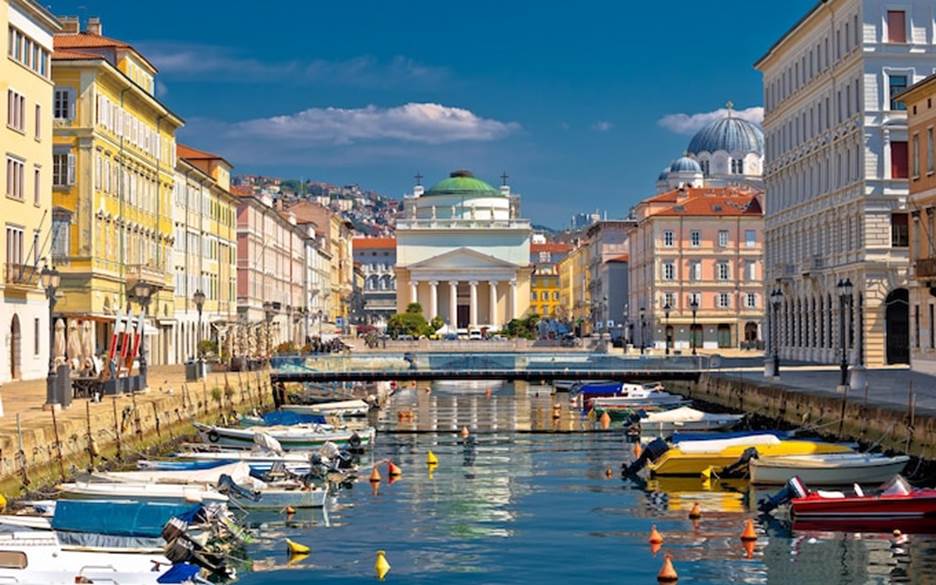
It’s as if a great forgetting has taken place when it comes to Trieste - Getty
Italy's Most Underrated City – with the Beauty of Venice but None of the Crowds
By Paula Hardy
A hundred years ago, Trieste was one of the great seaports of the world – an animated Riviera town, and a Mitteleuropean trading hub as easily accessible by rail from the Baltic as it was from Egypt by boat. The city’s home-grown shipping company, Lloyd Austriaco, pioneered the first leisure cruises, and helped bankroll the Suez Canal in order to ensure Trieste’s pivotal role between Europe and the rest of the world.
So, how is it these days that so few people are familiar with Trieste? While Venice hogs the headlines with the never-ending controversy of entry fees and giant cruise ships rocking its fragile lagoon, Trieste, barely two hours away, was designed for ocean-going traffic. It has a natural, 18-meter-deep port, a miles-long sandy beach and a handsome promenade with a string of jetties overlooked by luxurious Liberty-style hotels, including the Savoia Excelsior Palace , aka the “Ocean Liner Hotel”.
It’s as if a great forgetting has taken place. History, politics, geography, literature and, yes, even travel writing, have conspired to obscure Trieste’s obvious charms. In part, this is due to the immense success of the late Jan Morris’s acclaimed book, Trieste and the Meaning of Nowhere. Penned 20 years ago when she was 75, Morris was at the height of her writing powers and this beguiling book wove an elegiac web about the city. Every writer (and maybe every traveler) ever since has experienced Trieste through this regretful filter.
But Morris was always clear that the book was as much about her and her life of self-imposed exile: “I find myself all alone on the waterfront at Trieste, as it was long ago”. After all, she first encountered the city in 1945 as a young soldier in the 9th Queen’s Royal Lancers, a few days after it had been liberated from the Nazis. Trieste was on the wrong side of that war. Its port was devastated, its power curtailed, and its purpose gone.
Even more fatal to the city, hard borders sprung up all around, strangling its connections with Austria, Slovenia, Hungary and Croatia. In 1946, Churchill declared it the southern end of the Iron Curtain. Thus, Trieste migrated from the center-stage sea-gate of the Austro-Hungarian empire to the rusty end of a railway spur in the north-eastern corner of Italy. This was the nowhere “fold in the map” that Morris identified with.
But today Trieste is a different place altogether. Its shape-shifting geography altered again in 2004 thanks to the European Union’s dissolving borders as it expanded eastwards to include Hungary, Slovenia and the Czech Republic. “Trieste is no longer the city of Morris’s beautiful book,” Tatjana Familio told me as we lunched on the floating deck of Pier looking out at the preternaturally blue bay.

The vast port has been revitalized - Getty
“When I was young, it was my goal to live elsewhere. I lived in France, Scotland, Spain and Milan. But now I would not leave Trieste. Here I have everything, the mountains of the karst with their hiking trails and vineyards; weekend sailing; theatre, opera and great health care. And, I can be in Austria, Slovenia and Croatia all within an hour.”
A 165-acre, Unesco-recognized site, the Old Port of Trieste is so large it might be considered a neighborhood of the city. It occupies a sprawling waterfront location and its on-going revitalization will eventually see all of its 42 warehouses and stores converted into museums, exhibition halls, offices, hotels, apartments and restaurants.
Polishing off my glass of Vitovska, courtesy of on-trend, biodynamic, karst winemaker Skerk, I drift through the city. Morris was right: Trieste is the flaneur’s ultimate stage. Its setting is superb, situated as it is on an expansive bay, which fills with white sails come October during the largest regatta in the world, the Barcolana . There is a cathedral and a citadel upon its summit, a Roman amphitheater in its flank, and a knot of medieval streets at its core, which snake down the hillside to the sea.
But it is the city’s grand scale, broad boulevards and historic café culture that seems perfectly pitched at the modern traveler. Its architectural contemporaries are St Petersburg, Calcutta and Bath, and it shares their grandiloquent swank. There are pretty public gardens, avant-garde boutiques, craft beer and wine bars that tumble out onto every cobbled piazza, as well as a deep comingling of cultures, which places the Greek Orthodox, Serbian Orthodox and Catholic cathedral all within a few steps of one of Europe’s largest synagogues.

The Barcolana - Getty
What there isn’t is the tick-box tourism that saw so many historic centers struggling before the pandemic. Instead, there is a single epic art museum, the Museo Revoltella , beyond which there is a wealth of outdoor pleasures. There are pleasant hikes on the Carso Plateau, where the Strada Napoleonica weaves between vineyards offering osmize (pop-up cantinas). There are long cycle trails up the Val Rosandra or along the disused coastal railway line – the Parenzana – to Poreč in Istria. There are ferries to pretty Muggia, where you can scoff barbecued fish straight off the boat, or to Sistiana, where you can walk the coastal clifftops that inspired Rainer Maria Rilke. Or, you can simply while away the day in vintage city lidos or splashing off the beach at Barcola.
At a time when minds have become focused on more sustainable travel, Trieste fits the bill nicely. It’s naturally open outlook and deep-water port stand in stark contrast to Venice’s fragile, shallow lagoon, which has protected the city for centuries, precisely because it was difficult for ships to navigate. So, if you’re thinking of somewhere new to visit this autumn, try Trieste where life is looking up. – The Telegraph

